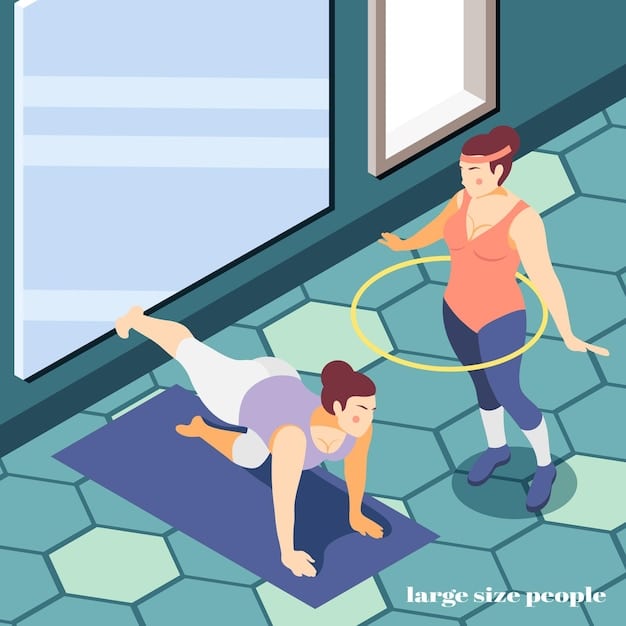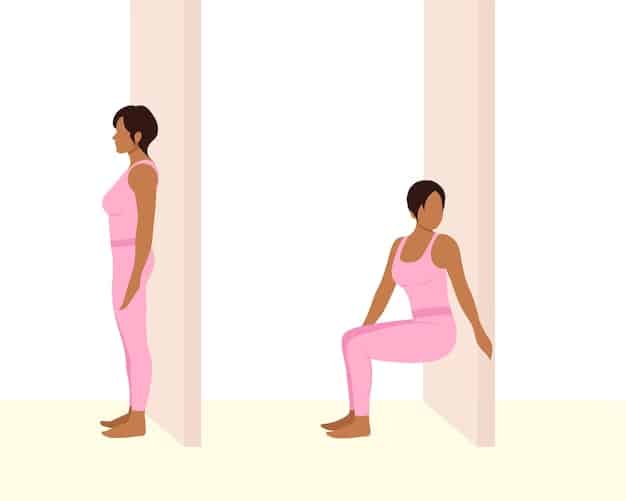Isometrics for Strength: Static Exercises for Unbreakable Stability

Isometrics for strength involve engaging muscles in static positions, enhancing stability and strength without movement, making them a versatile tool for fitness enthusiasts.
Unlock unbreakable stability and enhance your strength with isometrics for strength. These static exercises engage your muscles without movement, offering a unique and effective way to build power and resilience.
What are Isometrics?
Isometrics are exercises where you contract your muscles without visibly changing their length. Think of pushing against an immovable object. It’s a static form of strength training that can be done virtually anywhere.
Unlike dynamic exercises like lifting weights, isometrics focus on maintaining a constant position, which can lead to strength gains and improved stability.
The Science Behind Isometrics
When you perform an isometric exercise, you’re activating a significant number of muscle fibers. This high level of muscle activation strengthens the neuromuscular pathways, making your muscles more efficient and powerful.
Additionally, isometrics can help improve joint stability, crucial for preventing injuries and enhancing overall athletic performance.
- Neuromuscular Activation: Isometrics maximize muscle fiber recruitment.
- Joint Stability: Static holds reinforce joint alignment and reduce risk of injury.
- Accessibility: Can be performed without equipment, making them ideal for home workouts.
By incorporating isometrics into your training, you can target specific muscle groups and enhance your overall strength and stability.
Benefits of Isometric Training
Isometric training offers a range of benefits that can enhance your fitness regimen. From improving strength to boosting rehabilitation, these static exercises are a valuable addition to any workout routine.
Let’s explore the various advantages of incorporating isometrics into your training program.

Increased Muscle Strength
Isometrics can significantly increase muscle strength by engaging a large number of muscle fibers. Holding a static position forces your muscles to work hard, leading to strength gains over time.
This type of training is particularly effective for building strength at specific joint angles, which can be beneficial for sports and activities that require strength in certain positions.
- Targeted Strength: Build strength at specific joint angles.
- High Muscle Activation: Engage a large number of muscle fibers.
- Enhanced Power: Translate isometric strength into dynamic movements.
Consistent isometric training can improve your overall muscle strength, providing a solid foundation for other forms of exercise.
Types of Isometric Exercises
Isometric exercises come in various forms, each targeting different muscle groups and offering unique benefits. Understanding these types will help you incorporate them effectively into your fitness routine.
Here’s a closer look at some common isometric exercises and how they can be used to enhance your strength and stability.
Pushing Exercises
Pushing exercises involve applying force against an immovable object. This type of isometric exercise is excellent for building upper body strength.
Examples include pushing against a wall or holding a plank position. These exercises engage your chest, shoulders, and triceps, enhancing your pushing power.
Holding Exercises
Holding exercises require you to maintain a static position for a specific period. This type of isometric exercise is great for improving endurance and stability.
Examples include holding a squat position or a bridge. These exercises engage your core, legs, and glutes, enhancing your overall stability.

How to Incorporate Isometrics Into Your Routine
Incorporating isometrics into your routine is straightforward and can be done in various ways. Whether you’re a beginner or an experienced athlete, isometrics can be tailored to your fitness level and goals.
Here’s how to effectively add isometrics to your training program.
Warm-Up
Start with a light warm-up to prepare your muscles for the isometric exercises. This could include dynamic stretches like arm circles, leg swings, and torso twists.
A proper warm-up increases blood flow to the muscles and reduces the risk of injury.
Proper Form
Maintain proper form during each isometric exercise. This ensures that you’re targeting the correct muscles and minimizing the risk of strain or injury.
Focus on engaging your core and keeping your body aligned. If you’re unsure about the correct form, seek guidance from a fitness professional.
- Core Engagement: Keep your core tight for stability.
- Body Alignment: Maintain proper body alignment to avoid strain.
- Controlled Breathing: Breathe steadily throughout the exercise.
By following these guidelines, you can safely and effectively incorporate isometrics into your routine.
Sample Isometric Workout
To help you get started, here’s a sample isometric workout that you can incorporate into your fitness routine. This workout targets various muscle groups and can be adjusted to suit your fitness level.
Remember to focus on proper form and listen to your body throughout the workout.
Plank (Core)
Hold a plank position for 30-60 seconds. Engage your core, keep your body in a straight line, and breathe steadily.
Repeat 2-3 times with short rest intervals.
Wall Sit (Legs)
Lean against a wall with your knees bent at a 90-degree angle. Hold the position for 30-60 seconds.
Repeat 2-3 times with short rest intervals.
Advanced Isometric Techniques
Once you’re comfortable with the basic isometric exercises, you can explore advanced techniques to further challenge your muscles and enhance your strength gains. These techniques can help you break through plateaus and take your isometric training to the next level.
Here are some advanced isometric techniques to consider.
Overcoming Isometrics
Overcoming isometrics involve applying maximum force against an immovable object. This technique is excellent for building explosive strength.
For example, you can perform an isometric bench press by pushing upwards against a bar that’s secured in place. Focus on generating as much force as possible for a short period.
Yielding Isometrics
Yielding isometrics involve resisting a force that’s trying to push you out of position. This technique is great for improving stability and control.
For example, you can perform a yielding isometric squat by holding a squat position while someone applies gentle pressure to your shoulders. Resist the pressure and maintain your position.
| Key Point | Brief Description |
|---|---|
| 💪 Increased Strength | Isometrics enhance muscle strength without movement. |
| 🧘 Improved Stability | Static holds improve joint and core stability. |
| ⏱️ Time-Efficient | Effective workouts can be done quickly. |
| 🏋️ Versatile | Can be done anywhere, with no equipment. |
FAQ
▼
Isometric exercises involve contracting your muscles without changing their length. You’re essentially pushing or holding against an immovable object or force, engaging muscles statically.
▼
Aim for 2-3 times per week, with rest days in between. Consistency is key, but avoid overtraining. Listen to your body and adjust based on how you feel.
▼
Yes, when performed correctly. Maintain proper form and avoid holding your breath. If you have any existing injuries, consult with a healthcare professional.
▼
Yes, isometrics are often used in rehabilitation to strengthen muscles without putting stress on joints. They can help regain strength post-injury under professional guidance.
▼
No, that’s a major advantage! Many isometric exercises use your body weight or fixed objects like walls, making them easy to do anywhere without special equipment.
Conclusion
Incorporating isometrics into your fitness routine can significantly enhance your strength, stability, and overall athletic performance. These static exercises are versatile, time-efficient, and can be done anywhere. By understanding the principles and techniques of isometric training, you can unlock your potential and build unbreakable stability.





